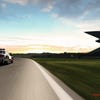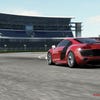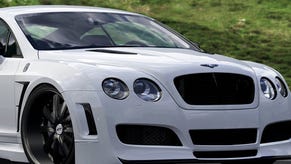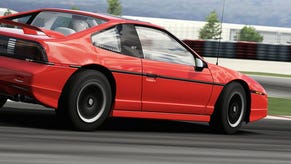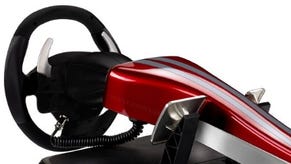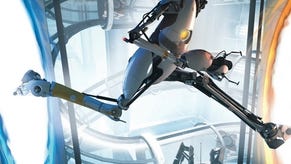Under the Hood of Forza 4
Turn 10 chief Dan Greenawalt on Gran Turismo, weather effects and power.
10 cars a month with DLC. Plus, we do listen to our community. Just like with Forza 3, it's not that we do everything everybody asks for, but we do look at how they play data wise. Our forums are very active. We try and nurture an active forum community. We also read other forums on other community sites. But we know from our data that the forums are not representing our larger community extremely well. There are a lot of people playing in a way that is totally different than what you'd think based on reading.
We have three primary lenses for deciding not only what features we do in a version, but also what title updates and things we change. We look at what people talk about, how they actually play, and our long term vision for where we want to go.
It makes for great stories for people. It's not what drives our team. Our team is driven towards that vision of car passion and car culture. And that's what gets us to accelerate. Now, obviously in my job it's important I play all the competition. I play everything. I play Grid, Need for Speed, Dirt, F1, everything. I play a lot of games in general. Part of it is just understanding what's going on. But that's not where our innovation, our ideas come from. That's just knowing where the landscape is. You can't navigate without knowing the landscape.
The other thing that's interesting is, with any of these giant franchises - we have over 350 people working on our team across the globe - when you think about that many people over two years, that's a lot of man hours. You can't maintain incredible agility at that size. We've restructured our team over and over again to give autonomy and freedom to leaders within the team to innovate within different areas. They can innovate in Kinect. We can hire specialists. We can innovate in graphics and hire specialists. We can innovate in physics.
But even so, even with the agility we get from that, we have to fire this artillery way in advance of trying to hit the hillside. So when a game comes out a year, six months, before we launch, we can't do anything about that. There's no reaction we can do at all. I can play it. I can appreciate what they do. We can't react. Which is why our stress is on innovation long term. If we don't innovate long term, we can't accomplish it.
Sometimes games come out with features at the same time. First-person shooters do and you go, oh, those guys copied that guy. I know that, just with the size of teams today, no they didn't. They came up with the same idea around the same time about a year ago and one game beat the other one to market. The ability to copy other games is extremely limited, honestly.
Every version we explore night and weather. We whittle down thousands of ideas, and we have these autonomous teams. We hire specialists. We build the game like an onion. At its core is a drop-dead amazing simulation engine. But we always assume we're wrong, and then find the best way to make it better. It's that commitment that makes me confident we have the strongest simulation, because we build partnerships other companies just can't, and we have a commitment to getting it right at our core.
We then build assists and fun gameplay and things on top of it without ever sacrificing that. Well, part of that is a solid 60 frames per second. And I mean solid. When you start doing multiple projected shadows off of the front of the car... we have 16 players, so 16 cars times two, so 32 projected shadows. That is a very graphically intense thing.
Now, that's totally possible on the Xbox 360, but it means the specialists we have in graphics would need to work on that problem, and it would be a hard problem. The hard problem we chose to take on with our graphics this version was Image Based Lighting, and working with Hollywood. Every version, we look at this long list of features we would do, and they are divided into these different autonomous groups that have the specialists that could actually do it. We just can't take a network developer and say, hey, why don't you do a new particle system. It's not that they're smart guys, but we hired them because they are so good at delivering network code.
Graphically, doing huge particle effects, we would have to have that group that was developing IBL, and that took a long time for us to get it right. We had to implement a whole new way of thinking through the partnership with Hollywood. We'd have to have them working on that from the ground up. So that's the type of thing where we could do it. We could do it on this hardware. But it didn't prioritise higher than IBL, because the IBL and the way the game looks now is stunning, and it's universal. It helps everybody, no matter what type of player you are, having a beautiful looking game that runs at 60 frames per second is awesome.
The things I've read on forums, people saying, well, I wish they didn't do this feature - first, that shows a lack of respect for the people who are going to love that feature, which is fine. I don't expect gamers to respect people the way I do. But, the assumption in that statement is, we have 350 people, why don't you just move them all on to this other thing I want?
It's like, I can't move artists onto it. That's not going to help. I can't move networking devs. I can't move my physics developers. I can't move my AI developers. To hire the best in the industry takes years. Years. To hire the type of guys we get, you have to take people from Hollywood and other game companies. It's the only way you get senior talent. So you can't just decide, we want to do more, let's just staff up.
There's no reason it has to be. There's more than one way to skin a cat. A lot of how we get our improvements, such as the graphics, was not with more hardware. It's actually through a knowledge of the hardware. It's actually easier to be on a platform after it's been several years out, because we can borrow from Epic, Rare, Lionhead, 343, and we give back to them.
Plus, we borrow from the rest of the industry: SIGRAPH, DICE, GDC. A lot of people think, what about the rivalry with this company? It's like, we all work in game development. Marketing teams rival. PR teams rival. Platforms rival. We're game developers, and we want to deliver a vision, so we're not really looking at the rivalry.
Hardware can always help, but only after you've had some time to trick the hardware. The reason we're able to do what we do is not by using the hardware the way it was supposed to be used. That's what happens on every version. Every game that looks great, the way it does it is by getting the hardware, learning every nook and cranny of it and tricking it into doing things more efficiently.
It's like packing up a moving van. When you unpack a van and you put it on your pavement and repack it, you get more space. Well also it's about knowing every nook and cranny of that van, so you're putting things in the glove box, and you're putting things where you were never supposed to store them. You've tricked it into doing more.
When you get new hardware, it's actually really hard to trick it because you need a couple of years to develop that. It's nice to have other developers like Epic, who are like, hey, we've found a spot, if you rip the door panel open you can shove some stuff underneath the window. The window doesn't work any more but that's OK, you've got more room in here.
There are a lot of PCs that are really powerful now and yet a lot of the games don't look much better because it's an unstable platform. You have to make it for the lowest common denominator. So, would more power and more RAM help? Always. But it wouldn't help immediately. And there's still plenty of things we can do on this hardware because it's not always the hardware that delivers the experience. Auto Vista, the new IBL, new physics engine, new AI... there's a lot of new innovation we have in this game. And this is our third version on this box. So innovation is a lot more than hardware.


